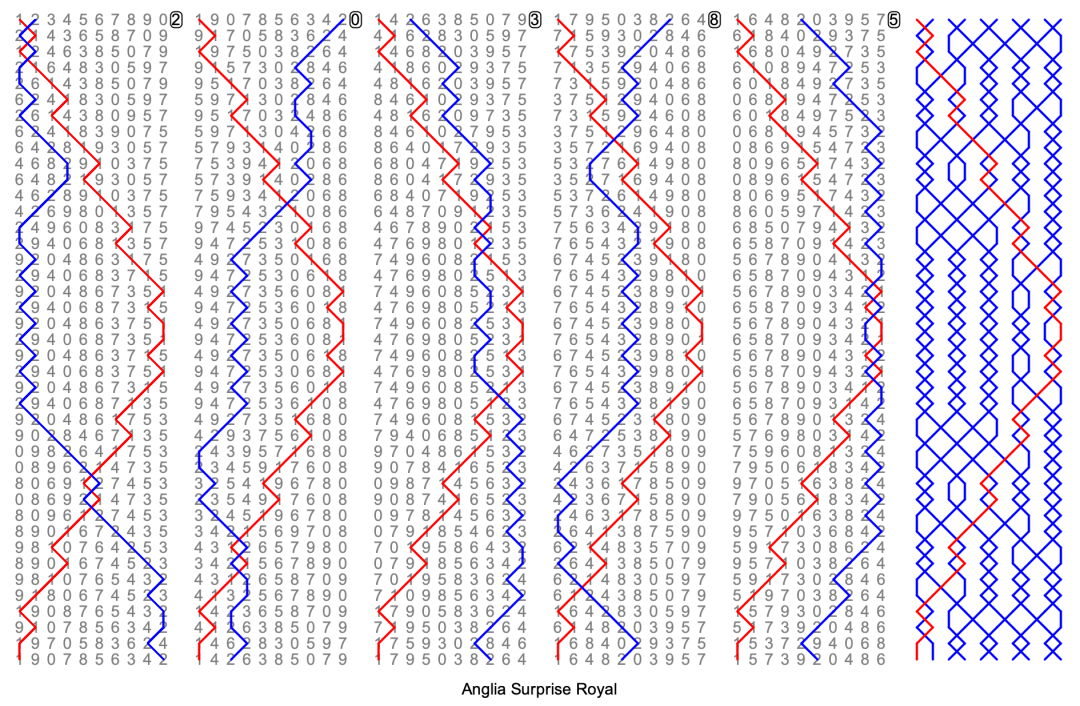I've mentioned before that I've started online handbell ringing again and have found myself in a ten-bell band with David Wilson, Jeff Ladd, Cara Capewell and Tom Farthing. The original idea was to progress to maximus, but we don't have a sixth person yet so we have mainly been ringing quarters of royal. So far we have rung Bristol, London, Vernet-les-Bains Delight, and Adelaide Surprise Major when not everyone was available.
The current project is Anglia Surprise Royal, which I suggested a couple of weeks ago. It's a right-place method with the distinctive feature of five-pull dodges in 1-2, 3-4 and 5-6 across the half lead. These give 567890 and 765432 roll-ups in the plain course. There are also four-pull dodges at the back, and some long places in 7-8, so overall quite a lot of stability.

We did manage a quarter last week, but the end was a bit of a scramble so we decided to ring it again this week. We didn't do so well, and didn't get through a plain course. While contemplating how we could improve, there was an interesting discussion about techniques for ringing handbells.
Our current band includes proponents of what I would say are the three main approaches. I, and I think also Cara, are ringing primarily by blue lines. Generally this approach tends to lead to what Philip Earis describes as "blue lines plus", meaning that one also takes advantage of knowledge of the structure. An example in Anglia would be knowing that 3rd and 4th places are made when the treble dodges in 5-6, and using that knowledge to anchor the work in 2nd and 8th place bells (shown in the diagram above) and their reverses.
David and Tom ring by place notation. This is evident in David's conducting - if there is a trip, he states the current places being made, e.g. "7ths" or "6ths" or whatever. Sometimes I find this helpful, sometimes not.
Jeff rings by the grid. When pressed as to exactly what this means, he explained that he visualises the grid and works his way through it in 4-row sections, and is definitely not thinking about the numerical place notation.
When I first started ringing surprise major on handbells, I did it by place notation because somewhere along the way I had picked up the impression that that's what surprise handbell ringers did. After a few peals, however, I decided that it was too difficult to recover from mistakes - specifically, I find that not having a view of my overall trajectory means that there's nothing to aim for if I am trying to get back on track after a mistake. Another point, at least in the standard methods, is that as the number of bells increases, the place notations tend to get harder (because your bells are positioned relative to a bigger space potential places to make) while the lines become easier (because of the prevalence of regular work such as treble bob hunting, especially in methods that are extended from lower stages).
I also maintained that ringing by place notation doesn't give me the same experience of ringing the pattern of the method, which is one of the things I enjoy about ringing. Tom disagreed with that view but we didn't continue the discussion long enough to dig into exactly how he experiences the method while stepping through the place notation.
I do make a couple of exceptions to my shunning of place notation. One is Double Norwich, for which the place notation is so simple and so obviously linked to the position of the treble that there seems to be little difference between ringing by place notation and ringing by the grid, and both are easier than tracking the lines. The other is surprise minor.
Perhaps we will continue the discussion after the next online session, hopefully after completing a quarter.
